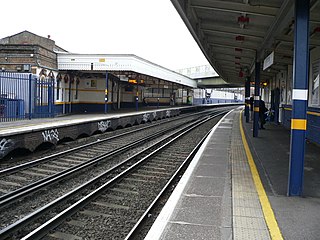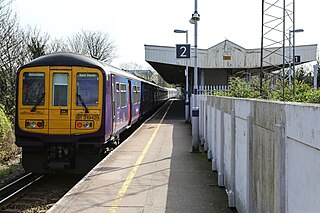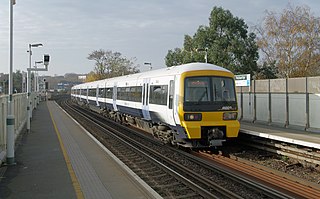
Crystal Palace is an area in South London, named after the Crystal Palace Exhibition building which stood in the area from 1854, until it was destroyed by fire in 1936. About 7 miles (11 km) southeast of Charing Cross, it includes one of the highest points in London, at 367 feet (112 m), offering views over the capital.

Sydenham is a district of south-east London, England, which is shared between the London boroughs of Lewisham, Bromley and Southwark. Prior to the creation of the County of London in 1889, Sydenham was located in Kent, bordering Surrey. Historically, the area was very affluent, with the Crystal Palace being relocated to Sydenham Hill in 1854. Today, Sydenham is a diverse area, with a population of 28,378 and borders Forest Hill, Dulwich, Crystal Palace, Penge, Beckenham, Catford and Bellingham.

Upper Norwood is an area of south London, England, within the London Boroughs of Bromley, Croydon, Lambeth and Southwark. It is north of Croydon. The eastern part of it is better known as the Crystal Palace area. The SE19 London postcode covers the entirety of the district.

The South London line is a railway line in inner south London, England. The initial steam passenger service on the route was established by the London, Brighton and South Coast Railway (LBSCR) on 1 May 1867 when the central London terminal stations of Victoria and London Bridge were connected to the inner south London suburbs of Battersea, Clapham, Brixton, Camberwell and Peckham. A pioneer of overhead electric traction, most of the line was built on high level viaducts and was marketed as the South London Elevated Electric Railway in the early part of the 20th century. The electric service was popular, with four trains per hour and 12 million passengers in 1920. Between Wandsworth Road and Peckham Rye the route ran parallel to another set of tracks. Prior to 1923, both lines from Wandsworth Road to East Brixton were owned by the London, Chatham and Dover Railway (LCDR) and the lines from East Brixton to Peckham Rye were owned by the LBSCR. The southern Atlantic lines were operated by the LBSCR and the northern Chatham lines were operated by the LCDR.

Crystal Palace railway station is a Network Rail and London Overground station in the London Borough of Bromley in south London. It is located in the Anerley area between the town centres of Crystal Palace and Penge, 8 miles 56 chains (14.0 km) from London Victoria. It is one of two stations built to serve the site of the 1851 exhibition building, the Crystal Palace, when it was moved from Hyde Park to Sydenham Hill after 1851.

Brixton railway station is a commuter railway station in Brixton, South London, UK. It is on the Chatham Main Line, 3 miles 14 chains (5.1 km) down the line from London Victoria. Trains are operated by Southeastern. The typical service is one train every 15 minutes in both directions, from Victoria to Orpington via Bromley South.

Peckham Rye is a railway station in Peckham town centre, South London. The station is served by Southern, London Overground, Southeastern and Thameslink.

The London, Chatham and Dover Railway was a railway company in south-eastern England. It was created on 1 August 1859, when the East Kent Railway was given parliamentary approval to change its name. Its lines ran through London, and northern and eastern Kent, to form a significant part of the Greater London commuter network. The company existed until 31 December 1922, when its assets were merged with those of other companies to form the Southern Railway as a result of the grouping determined by the Railways Act 1921.

Nunhead railway station is in the Nunhead area of the London Borough of Southwark. It is 5 miles 77 chains (9.6 km) measured from London Victoria. The station is managed by Thameslink. It is in Travelcard Zone 2.

The Catford loop line is a railway line in southeast London. It carries a suburban stopping passenger service from central London to Sevenoaks, and is also a relief route for the Chatham Main Line carrying passenger trains from London Victoria to the Kent coast. There is also much freight activity as this is the main route to Willesden and the north via Latchmere Junction. Freight traffic includes aggregates trains to and from locations along the Thames estuary, and Kent, aviation fuel running between Colnbrook and the Isle of Grain, and a small number of international workings from the Channel Tunnel via the yard at Dollands Moor. Until around 2013, a significant quantity of intermodal traffic from Thamesport used the line - however, the opening of London Gateway meant that the larger container ships stopped serving Thamesport and this traffic then ceased.

The Crystal Palace and South London Junction Railway was authorised to build a line from Peckham Rye railway station to a terminus at Crystal Palace in 1862, in order to serve the attraction of the Crystal Palace.

Crystal Palace (High Level) was a railway station in South London. It was one of two stations built to serve the new site of the Great Exhibition building, the Crystal Palace, when it was moved from Hyde Park to Sydenham Hill after 1851. It was the terminus of the Crystal Palace and South London Junction Railway (CPSLJR), which was later absorbed by the London, Chatham and Dover Railway (LCDR). The station closed permanently in 1954. As of June 2024, however, restoration work on the Grade II listed station was underway using £2.8m of grant funding; on completion, the station is expected to be removed from the Heritage at Risk Register.

The A2216 is an A road in south London, England suburbia. It runs from the A215 in Denmark Hill to the A212 in Sydenham. Part of the road is an ancient thoroughfare, Lordship Lane. In Dulwich, the road runs via the A205 South Circular Road.

East Brixton railway station was a railway station in Brixton, south London. It was opened as Loughborough Park by the London, Brighton & South Coast Railway in 1866. Regular passenger service was the South London line from London Victoria to London Bridge terminal stations in central London. Initially provided with a steam passenger service, competition from electric trams caused a conversion to overhead line electric operation in 1909. The station became part of the Southern Railway in 1923 and overhead line electrification was swapped for third rail in 1928. The station lost patronage after the opening of Brixton Underground station in 1971. There was a fire at the station in 1975 and it was closed by British Rail in January 1976. The station was located next to the rail bridge over Barrington Road, near Coldharbour Lane. Since 2012 London Overground trains pass through the site of the former station without stopping and there has been some campaigning to reopen it.
Honor Oak railway station was a station opened in December 1865 in Honor Oak, London by the London, Chatham and Dover Railway on the Crystal Palace and South London Junction Railway. The line was built to carry passengers to The Crystal Palace after its move from Hyde Park. The station featured two wooden platforms, and apart from two brief closures during World War I and World War II, it remained open until 1954 when the entire branch line was closed. The station was demolished around 1956–7 and afterwards the site has been redeveloped with housing.

Lordship Lane was a railway station in East Dulwich, in what was the Metropolitan Borough of Camberwell in south London, on the Crystal Palace and South London Junction Railway. It was opened by the London, Chatham and Dover Railway (LCDR) on 1 September 1865 and took its name from Lordship Lane, the thoroughfare on which it stood.

Sydenham Hill Wood is a ten-hectare wood on the northern slopes of the Norwood Ridge in the London Borough of Southwark. It is designated as a Local Nature Reserve and Site of Metropolitan Importance for Nature Conservation. With the adjacent Dulwich Wood, Sydenham Hill Wood is the largest extant tract of the ancient Great North Wood. The two woods are formed from coppices known as Lapsewood, Old Ambrook Hill Wood and Peckarmans Wood after the relocation of The Crystal Palace in 1854 and the creation of the high level line in 1865.
Network Rail's (NR) South London Route Utilisation Strategy (SLRUS), published in March 2008 (SLRUS) was the eighth Route Utilisation Strategy to be produced. By default, RUSs are established by the Office of Rail Regulation (ORR) unless the latter objects within 60 days. The RUS is included in NR's map as established.

The Tooting, Merton and Wimbledon Railway (TM&WR) was a railway company jointly operated by the London and South Western Railway (LSWR) and the London, Brighton and South Coast Railway (LBSCR) in Surrey.

The Portsmouth line is a secondary main line originally built by the London, Brighton and South Coast Railway and the London and South Western Railway between 1847 and 1868. It leaves the South London Line at Peckham Rye, with connections to the Victoria branch of the Brighton Main Line at Streatham, and continues via Sutton, Epsom and Dorking to join the Mid-Sussex Line at Horsham.




















